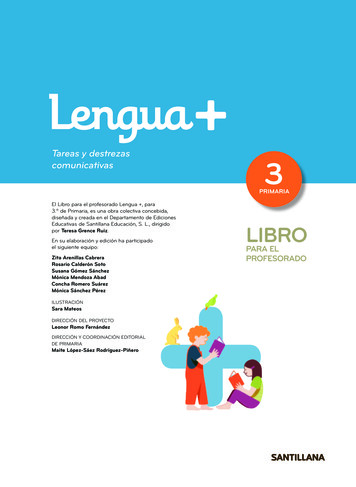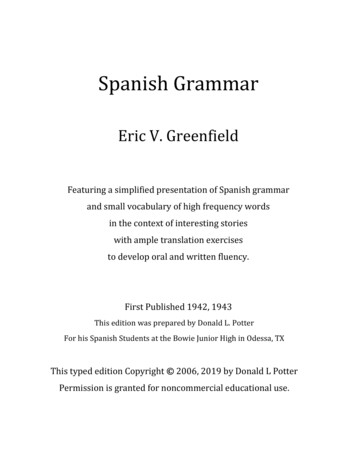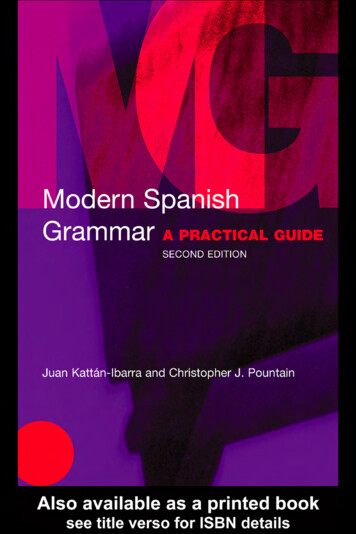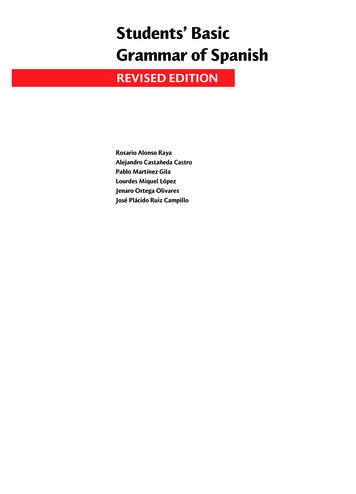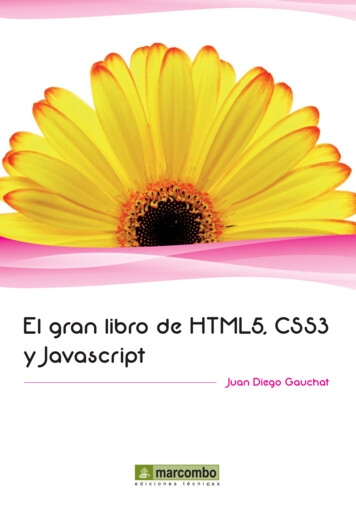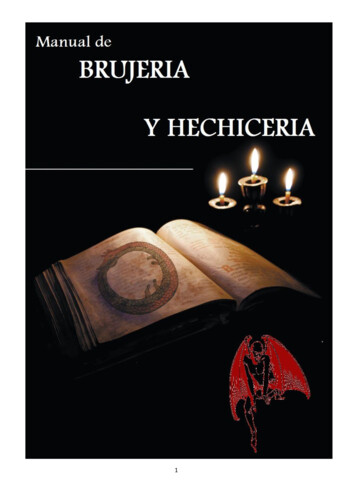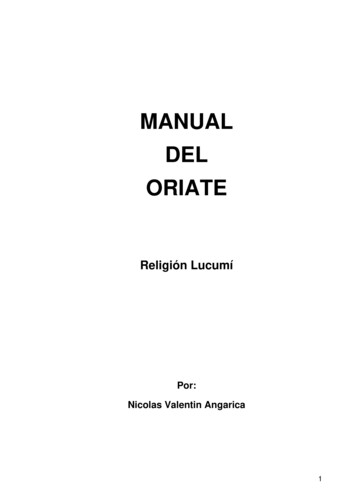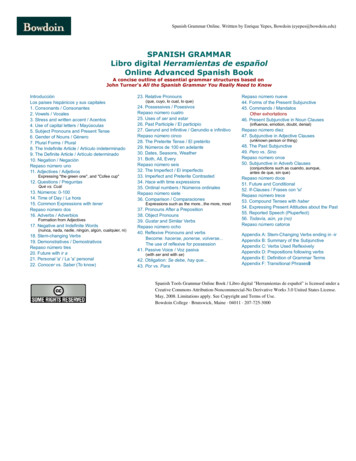
Transcription
Spanish Grammar Online. Writtten by Enrique Yepes, Bowdoin (eyepes@bowdoin.edu)SPANISH GRAMMARLibro digital Herramientas de españolOnline Advanced Spanish BookA concise outline of essential grammar structures based onJohn Turner's All the Spanish Grammar You Really Need to KnowIntroducciónLos países hispánicos y sus capitales1. Consonants / Consonantes2. Vowels / Vocales3. Stress and written accent / Acentos4. Use of capital letters / Mayúsculas5. Subject Pronouns and Present Tense6. Gender of Nouns / Género7. Plural Forms / Plural8. The Indefinite Article / Artículo indeterminado9. The Definite Article / Artículo determinado10. Negation / NegaciónRepaso número uno11. Adjectives / AdjetivosExpressing "the green one", and "Cofee cup"12. Questions / PreguntasQué vs. Cuál13. Números: 0 10014. Time of Day / La hora15. Common Expressions with tenerRepaso número dos16. Adverbs / AdverbiosFormation from Adjectives17. Negative and Indefinite Words(nunca, nada, nadie, ningún, algún, cualquier, ni)18. Stem changing Verbs19. Demonstratives / DemostrativosRepaso número tres20. Future with ir a21. Personal 'a' / La 'a' personal22. Conocer vs. Saber (To know)23. Relative Pronouns(que, cuyo, lo cual, lo que)24. Possessives / PosesivosRepaso número cuatro25. Uses of ser and estar26. Past Participle / El participio27. Gerund and Infinitive / Gerundio e infinitivoRepaso número cinco28. The Preterite Tense / El pretérito29. Números de 100 en adelante30. Dates, Seasons, Weather31. Both, All, EveryRepaso número seis32. The Imperfect / El imperfecto33. Imperfect and Preterite Contrasted34. Hace with time expressions35. Ordinal numbers / Números ordinalesRepaso número siete36. Comparison / ComparacionesExpressions such as the more.the more, most37. Pronouns After a Preposition38. Object Pronouns39. Gustar and Similar VerbsRepaso número ocho40. Reflexive Pronouns and verbsBecome: hacerse, ponerse, volverse.The use of reflexive for possession41. Passive Voice / Voz pasiva(with ser and with se)42. Obligation: Se debe, hay que.43. Por vs. ParaRepaso número nueve44. Forms of the Present Subjunctive45. Commands / MandatosOther exhortations46. Present Subjunctive in Noun Clauses(influence, emotion, doubt, denial)Repaso número diez47. Subjunctive in Adjective Clauses(unknown person or thing)48. The Past Subjunctive49. Pero vs. SinoRepaso número once50. Subjunctive in Adverb Clauses(conjunctions such as cuando, aunque,antes de que, sin que)Repaso número doce51. Future and Conditional52. If Clauses / Frases con 'si'Repaso número trece53. Compound Tenses with haber54. Expressing Present Attitudes about the Past55. Reported Speech (Pluperfect)56. Todavía, aún, ya (no)Repaso número catorceAppendix A: Stem Changing Verbs ending in irAppendix B: Summary of the SubjunctiveAppendix C: Verbs Used ReflexivelyAppendix D: Prepositions following verbsAppendix E: Definition of Grammar TermsAppendix F: Transitional Phrases Spanish Tools Grammar Online Book / Libro digital "Herramientas de español" is licensed under aCreative Commons Attribution-Noncommercial-No Derivative Works 3.0 United States License.May, 2008. Limitations apply. See Copyright and Terms of Use.Bowdoin College · Brunswick, Maine · 04011 · 207-725-3000
Libro digital Herramientas de españolSpanish Tools Online Grammar BookA concise outline of essential grammar structures based onJohn Turner's All the Spanish Grammar You Really Need to KnowINTRODUCTIONUSING THESE SPANISH GRAMMAR TOOLSINTRODUCCIÓNEL USO DE ESTAS HERRAMIENTAS DE ESPAÑOLThis text is intended for students who are familiarwith most of the basic Spanish grammar, and whoare ready to take their knowledge and comfortlevel one step further. Its aim is to meet yourbasic needs for advanced work as concisely andthoroughly as possible. Each section presents aspecific aspect of the use of the language, andthen offers a brief practice so that you can verifyyour understanding of the material and feel moreconfident to use it. The Reviews, on the otherhand, challenge you to put together the contentsof previous sections, allowing you to get thedetails under control and promoting a moreprecise awareness of the way Spanish works.Este texto está destinado a estudiantes que yaconocen la mayor parte de la gramática básica delespañol, y que se preparan para dar un pasoadelante en su comodidad con el idioma. La meta esresponder a sus necesidades básicas hacia el nivelavanzado lo más concisa y exhaustivamente posible.Cada sección presenta un aspecto específico en eluso del idioma, y luego ofrece una práctica brevepara que usted pueda verificar su comprensión delmaterial y aumentar su confianza al usarlo. LosRepasos, por su parte, le exigirán integrar elcontenido de secciones previas, para permitirlecontrolar los detalles y promover mayor precisión ylucidez sobre el funcionamiento del español.A second goal for these tools is to serve as areference work as you write. The table of contentsprovides you with a checklist to edit your writing,and the diagrams can be used for a quick review.The lists and summaries in the appendices canprove useful, too.Un segundo objetivo es que estas herramientassirvan de referencia al escribir. La tabla decontenido funciona como lista de verificación y losesquemas sirven para un repaso rápido. Las listas yresúmenes de los apéndices pueden también ser deutilidad.Many of the explanations and most of theorganization of materials in this text come fromJohn Turner's All the Spanish Grammar You ReallyNeed to Know course package. A special word ofgratitude to Professor Turner for his clear,effective style.Muchas explicaciones y el grueso de la organizaciónde este material provienen del módulo All theSpanish Grammar You Really Need to Know, delprofesor John Turner, cuyo estilo claro y efectivomerece especial reconocimiento.Written by Enrique Yepes
Libro digital Herramientas de españolSpanish Tools Online Grammar Book1. Consonants / Las consonantesSpanish spelling is pretty consistent: most letters represent a single sound regardless of theirposition in a word. Note the following peculiarities:H la hache is never pronounced. Thus, words like Honduras, ahora and alcohol have noaspiration before the /o/ sound.CH la che is always pronounced as in "cheers": coche, ocho.La hache is not combined with any other consonants: there is no th, sh, ph, gh, etc.(English "ph" may translate to "f": filosofía, Filadelfia, fantasma).C la ce is pronounced /k/ (as in "case") in most positions: caso, cosa, cuota, frecuente, crisis. Before e, i, it is pronounced /s/ (as in "sin") in America or /th/ (as in "thin") in Spain: cielo,acento. The /k/ sound (as in "kiss"), is spelled "qu" (mute "u") before e, i: queso, quince.G la ge is pronounced /g/ (as in "go") in most positions: gala, gota, guante, globo. Before e, i, it is pronounced almost like /h/ (as in "hen"): general, gitano. The /g/ sound (as in "get"), is spelled "gu" (mute "u") before e, i: guerra, guitarra.If the letter "u" is to be pronounced in a "gue/gui" combination, it is marked with a diaeresis (ladiéresis): pingüino, bilingüe, nicaragüense.Q la ku is used only in the que/qui combinations, and the "u" is always mute in this position.Therefore, the word quinteto has no /u/ sound, and English "quota" and "frequent" translate tocuota and frecuente.Z la zeta is pronounced /s/ in America and /th/ in Spain.Spanish avoids the ze/zi combination and prefers ce, ci: lápiz lápices ; cebra, cenit.Only four consonants can be duplicated to represent specific sounds: cc is used before "e" or "i" only and sounds /ks/ (/kth/ in Spain): acción and acceso butacento, ocurrir. ll sounds /y/: calle, llama but ilegal, aludir, inteligente. rr represents the famous "rolling r" between vowels only: perro, carro vs. pero, caro. nn is used only when a prefix ending in "n" is added to a word beginning with "n":innecesario, connotación, but anual, anotación, conexión.No other consonants are duplicated in Spanish: efectivo, común, oportunidad, imposible.Summary / ResumenNever pronounce the letter H (hache): alcohol, ahora, humano, Honduras, holocausto.Hard C sound: /k/ as in kissS/Z sound:/s/ or /th/ as in sink/thinkHard G sound: /g/ as in getSoft G sound: /h/ as in henca que qui co cuza ce ci zo zuga gue gui go guja je ji jo ju ge gibuscar, busquérealizar, realicépagar, paguéhija,gitanoAs you see, vowels e and i are exceptional in their combination with g and c.The words que, quien, guerra and guitarra may help you remember these spelling changes.No double consonants except rr, ll, cc and nnph f : filosofía
2. Vowels / Las vocalesSpanish has five vowel sounds a, e, i, o, u , pronounced the same way regardless of their positionin a word:a. like the a sound in "father": casa, almae. like the e sound in"let": lee, cenai. like the ee sound in "leek": mil, millajeo. like the aw sound in "lawn": son, hojau. like the oo sound in "loom": tú, Honduras (u is mute in que, qui, gue, gui) i and u are called "weak" (débiles o cerradas) because, in combination with another vowel, aregenerally pronounced as one syllable: Ruiz, fue, dio, have only one syllable. These areconsidered true diphthongs in Spanish —two vowels in one syllable—, as in a·gua or vien·to. a, o, and e are called "strong" (fuertes o abiertas). Two strong vowels are pronounced as twosyllables: po·e·ma has three syllables, ca·os has two. These are not true diphthongs, since thevowels belong in different syllables.http://www.bowdoin.edu/ eyepes/newgr/ats/01a02.htm2/2
Libro digital Herramientas de españolSpanish Tools Online Grammar Book3. Stress and written accent / Los acentosEvery word has a stressed syllable (sílaba tónica). For example, the word español stresses thelast syllable.Word endings and written accents (tildes) provide a predictable guide to stress syllables in Spanish,allowing you to read any word correctly.A. BASIC RULES FOR THE USAGE OF ACCENTS / REGLAS BÁSICAS DE ACENTUACIÓN1. Words that end in a vowel, n, or s stress the next to last syllable: clase, examen, mesas.2. Words that do not end in a vowel, n, or s, stress the last syllable: bondad, papel, cantar.Words that do not follow the above rules carry a written accent to show which syllable is stressed:(does not follow rule 1: it ends in a vowel but stresses the last syllable)café(neither the last nor the next to last syllable is stressed)exámenes(does not follow rule 2: it does not end in a vowel, n or s, but still stresses the next to last syllable)árbolAccording to the basic rules, thus, you need two criteria to decide whether a word needs a tilde ornot:a) its ending,b) which syllable is stressed.The word región needs a tilde becausea) it ends with "n" butb) the penultimate syllable is not stressed.The word regiones does not need a tilde becausea) it ends with "s" andb) the penultimate syllable is stressed.
B. OTHER USES OF THE WRITTEN ACCENT / OTROS USOS DE LA TILDE3. The written accent also indicates stress on a weak vowel (i, u) that is followed or preceded by astrong vowel (a, e, o): dí·a, Ma·rí·a, Ra·úl, o·í·do, a·hí, ra·íz, mí·o, dú·o, ge·o·gra·fí·aBUT: democracia (the weak vowel "i" is not stressed, therefore rule 1 applies)4. A written accent is not used for one syllable words (fe, ti, tres, Dios), except to distinguishbetween certain words that are otherwise spelled identically, such as:degive (command)déelélhe/himmasmore másmimímevs.séseI knowsísiyestéteteatútuyouof, fromthebutmyreflexive/impersonal pronounifyou (object pronoun)yourAnother common group of such pairs are words like que, which need a written accent when usedas a part of a direct or indirect question (see §12):¿Qué dices? What .?¿cómo llego? how .?Sabe dónde estoy. He knows where I am.Digo que hace calor I say that.como quieras as.Estoy donde te dije. I am where I told you.
Libro digital Herramientas de españolSpanish Tools Online Grammar Book4. Use of Capital Letters / El uso de las mayúsculasSpanish uses capital letters in the sames cases English does, with the following importantexceptions:1. Not used for days, months or religions: lunes, martes, enero, febrero, el budismo, uncatólico.2. Used for geographical names such as rivers, countries and cities (Bolivia, Los Angeles), but notused for the adjectives: venezolano, norteamericano, panameña, guatemalteco, caribeño.3. In long titles (of books, movies, etc.), only the first word and any proper nouns are capitalized:La cabaña del tío Tom, Antología del cuento hispánico, Cien años de soledad.
5. Subject Pronouns and Present Tense/Los pronombres de sujeto y elpresenteThe verbs hablar (speak), comer (eat) and vivir (live) are "regular" or predictable in theirendings. Here are their forms in the present indicative with the corresponding subject pronouns*:hablarcomervivirISubject Pronounsyohablocomovivoyou (familiar, singular)túhablascomesvivesyou (formal, singular)usted (Ud.)heélhablacomevivesheellawenosotros/as hablamos comemos vivimosyou (fam. in Spain,plural)vosotros/as habláisyou (formal in vivenellasRegular verbs ending in gir/ ger, cir/ cer, and guir have a spelling change in the present tense yo form (ending in o) in order to preserve the sound of the stem: gir/ ger jo. Example: recoger (pick up): recojo, recoges, etc. ('go' would sound just likeEnglish 'go') cir/ cer zo. Example: vencer (overcome): venzo, vences, etc. guir go. Example: extinguir (extinguish): extingo, extingues, etc.Subject pronoun usage1. Since the verb endings contain clues as to the speaker, subject pronouns are only used whenrequired for clarity or emphasis (although usted is often used as a courtesy).2. When addressing friends, children, animals, and God, tú is used. The form usted (commonlyabbreviated to Ud.), which uses third person verb forms, is used for polite address to people youdo not know well or wish to express respect for. Ustedes is used as plural for both for
Spanish Tools Online Grammar Book. 3. Stress and written accent / Los acentos. Every word has a stressed syllable ( sílaba tónica ). For example, the word español
